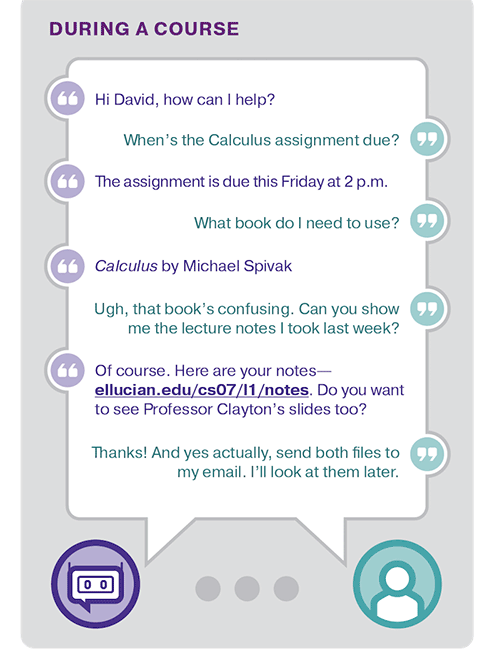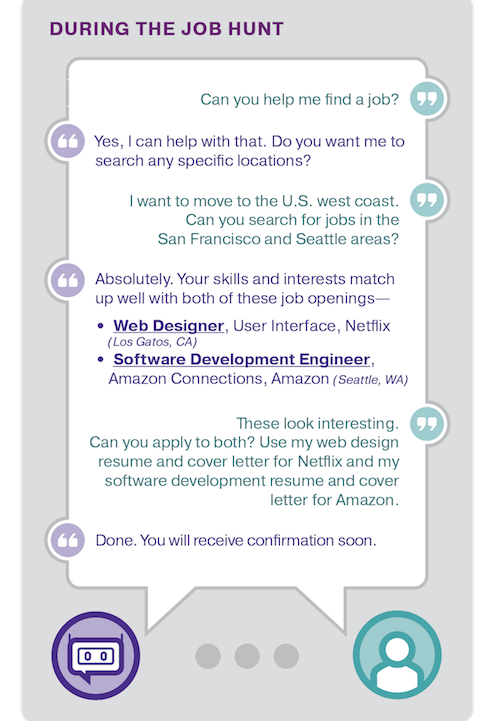The student experience will come with a personal assistant

Key takeaways
- Chatbot technology is the future, yet also has some challenges
- Chatbots will deepen analytics capabilities for institutions
- Chatbot technology won't replace human interaction, but will augment it
Chatbots: The all-in-one assistant, advisor, and student services administrator
Talking to a machine in a natural language like we use with our friends is not science fiction anymore. Advancements in machine learning, natural language processing (NLP), and artificial intelligence have made this a reality, and students are poised to benefit.
With a variety of voice-based assistant devices in the market (Alexa, Google Home, and Apple Homepod) this is already a technology found in many homes. Chatbot technology functions similarly, but through text conversations, and is experiencing a surge in the form of a sharp increase in apps powered by chatbot technology.
Further development of chatbot technology in higher education will bring about exciting innovation, where students are hungry for a more connected technology experience. Chatbot applications will have use throughout the student lifecycle by providing everything from on-demand advising and degree-planning services, resolving a wide range of administrative tasks, helping students look for mentorship or career opportunities, or connecting students with volunteer opportunities or alumni groups.
For instance, Leeds Beckett University in the UK is using chatbots to help students find unfilled seats in courses. BI Norwegian Business school is implementing chatbots that respond to questions from students on assignments. And Georgia State University uses chatbots to help fight summer melt.
Though conceived as a tool of convenience, chatbots will track, analyze, and adapt realtime to massive amounts of student data. Leveraging chatbot and voice-assistant technology could revolutionize the student experience.
Better chatbots mean better conversation
Chatbot technology has been around for decades, but there have always been limitations in the way the phrases had to be constructed and in the responses computers could deliver.
Thanks to the development of applications built on natural language processing (NLP), computers can understand phrases in a robust manner and respond by performing a wide spectrum of complex actions—like processing multiple commands within a single sentence, producing a reaction that “remembers” something you shared in a previous conversation, or integrating user data with other apps as well as with broader information systems.
Just a few years ago, mobile phones introduced voice-based assistants like Google Assistant for Android devices, Cortana for Windows devices, and Siri for iOS devices. When these assistants were introduced, they were capable of processing one instruction at a time and delivering a response. When a second question was asked, the context of the conversation was already lost.
Challenges in improving chatbot technology
Although natural language processing has improved vastly, there is a great deal of research that is happening to overcome remaining barriers:
- Accents and dialects. Chatbots come with a variety of English variants already built in, like English (US) and English (UK), and Amazon recently added English (Indian) to Alexa—but there’re plenty more accents to account for. And when it comes to regional dialects, such as the different ways English speakers use the word “bill,” it takes more sophisticated programming for chatbots to “learn” how a speaker uses these words with more context-dependent meanings.
- Nonverbal gestures.Whether we notice how much we all rely on nonverbal cues and gestures, they carry a lot of meaning in every conversation (even when only audio or text is involved). The same technology that now allows facial recognition on the latest smartphones could be used to help interpret this information.
- Emotions. My team is currently working on how chatbots respond to the emotions and tone of a user. When a prospective student looks and sounds confused as he interacts with an online student service portal, the chatbot can recognize his facial expressions and verbal intonations and offer to guide the student through the application process. The same technology can be applied to accumulate and transmit feedback from a class based on the emotional responses of all the students in attendance.
How chatbots will improve the student experience
Chatbots can have a significant impact on the student throughout their life on campus. There are a variety of student services today that can be better served by Chatbots, in terms of convenience and efficiency—and the ability for applications to capture and process these interactions as student data can further heighten the analytics capabilities of institutions.
Here are just a few examples:

Chatbots can be a very effective teaching assistant in answering the queries of students. Based on the type of questions asked over time, and the type of assistance needed, chatbots can help professors develop the curriculum.

Chatbots can help students find the jobs that interest them and also match the skills they’ve learned in the courses they’ve completed. They can help them submit applications, practice for interviews, and connect with mentors, internships, or other career development opportunities.
Personal assistant in the dorm room
The video below, from our eLive conference in 2017, is Ellucian’s demonstration of the use of this technology in the dorm room of the future.

Chatbots, coupled with voice-assistant technology, make a great personal assistant to the student in the dorm room, helping manage schedules and coursework, sign up for events, and registration for courses.
In the very near future
Chatbots will become a preferred interface, just like how touch-screen technology revolutionized the mobile phone industry a decade ago. It’ll take some time for institutions to figure out how best to implement this technology (check out the tips at the end of our voice assistants blog, here).
It is important to emphasize that chatbot and voice-assistant technology will not replace human to human interactions on campus. There will always be conversations that are richer and more helpful to have face-to-face with an advisor, professor, classmate, mentor, or administrator.
Today, there is a great deal of information tracked by schools on what factors help students succeed—and students are willing to contribute that data for a more integrated digital experience—which also helps enhance institutional operations. With the ability to track and analyze a potentially huge amount of student data, chatbots will only help in this endeavor, supporting the faculty and administrators who support the students at the center of it all.




